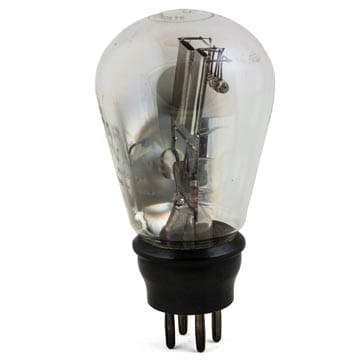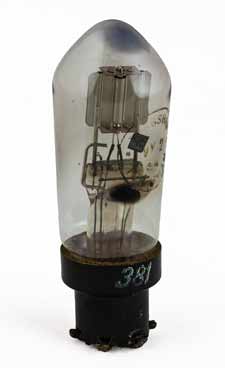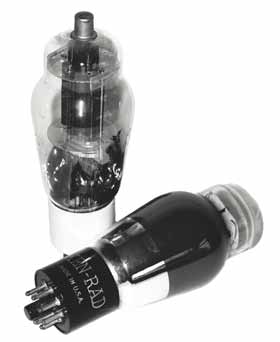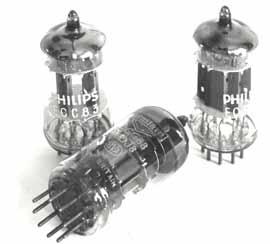Vacuum Tube Thermionic Valve Development
The story of the thermionic valve or vacuum tube continues with the further developments and improvements made.
History of the Valve / Tube Includes:
History overview
Early discoveries
Fleming's oscillation valve
de Forest's Audion
Development of the basic idea
R-type valve
6L6 valve
EF50 valve
With the vacuum tube or thermionic valve now established, its performance left much to be desired in many areas.
Gain levels were low, and the valves or tubes were prone to oscillation.
One of the major issues was that people did not fully understand the way in which they operated.
Further development and research as neeed.
Valve developments
In these early days of vacuum tubes, their operation was not fully understood and there were a number of misconceptions. One idea that was held it was thought that some gas molecules were needed in the envelope for it to operate correctly. These tubes were known as "soft" tubes. It was not until 1915 when an American scientist named Langmuir proved that gases were not required in the envelope. Soon after this discovery new highly evacuated tubes known as "hard" tubes were produced and these exhibited far better levels of performance.
In addition to basic improvements the full evacuation of the envelopes brought a number of other improvements. Filaments could now be coated to improve their electron emission. Previously any coatings would have been contaminated. Filament temperatures could also be reduced and this improved reliability as well as reducing the heater current consumption.
Large numbers of the new tubes were manufactured. A French engineer named Ferrie designed one designated the TM valve for the French military authorities. Over 100 000 of these were produced. In Britain a similar valve called the Type R was produced and this was manufactured in equally large quantities.

Marconi U5 rectifier valve
More in the envelope
With the very high levels of anode grid capacitance exhibited by these early vacuum tubes, it was very difficult to prevent the circuits that used them from bursting into oscillation when they were used at frequencies above a few hundred kilohertz. Several attempts were made to overcome the problem. In 1916 H.J. Round produced a low capacitance valve known as the Type V24. For this tube, Round used the novel idea of keeping the anode lead away from the grid by passing it out of the top of the glass envelope and not through the base at the bottom. Whilst this gave a significant improvement, it was not the complete answer.

Tungsram VY2 Rectifier
The solution to the problem was derived in 1926 by adding a further grid. Known as the tetrode this vacuum tube used a second grid known as a screen grid between the first or control grid and the anode. Its introduction reduced the anode to control grid capacitance to almost zero and solved the problem of instability.
Then in 1929 the tetrode itself was improved by the introduction of another type of vacuum tube termed the pentode. This tube had a total of five electrodes, the additional one being a third grid called the suppressor grid. This overcame the problem encountered with the tetrode of a discontinuity in its characteristic caused by electrons bouncing of the anode.
Apart from making improvements in the operation of valves by adding additional grids, further improvements were made in the heater arrangements. One of the main problems with early tubes was that the circuit configurations were limited because the heater and cathode were one and the same. It was discovered that the cathode could be indirectly heated and this meant that the heaters could be electrically isolated from the cathode. This had the advantage that the heaters did not need to be run from a battery supply supplying DC. Instead an AC supply derived from the mains could be used. This was a major improvement because it meant that size of radios could be considerably reduced as could their running costs.

6L6 & 807 Valves / Tubes
Increase In Use
The introduction of the tetrode and pentode brought revolutionary improvements in performance. As a result the use of vacuum tubes rose dramatically. Not only were thermionic valves used in radios which by this time were very popular, but they also found many other uses. By the late 1930s many thousands of different types of vacuum tube were being manufactured, and there was a large number of different manufacturers which were appearing both in the USA and in Europe.
Many of the vacuum tubes introduced in this period have long since disappeared from common use. However there are a few which were very successful remaining in new designs for a long time. One such valve was the 6L6 used in many guitar amplifiers until quite recently. In many ways it was quite revolutionary because it was the first beam tetrode. It used a new technique to overcome the discontinuity in the characteristic of the tetrode caused by electrons bouncing of the anode. Rather than using a suppressor grid it used a new arrangement connected to the screen grid. This tube became so popular that it was later modified for RF applications by giving it a top cap for the anode. This vacuum tube was called the 807 and was widely used in transmitters in the Second World War and afterwards.
Prior to the war all tubes had used special metal or plastic bases attached to the glass envelope to hold the pins. After the war miniaturization and improvements in manufacturing techniques enabled the pins to be mounted into the glass envelope. By doing this much smaller tubes were made and costs were reduced.
Vacuum tubes today
The reign of the thermionic valve did not last forever. Developments in semiconductors that resulted in the invention of the transistor in 1948 meant that smaller, reliable, and less power hungry devices could be made. The success of the transistor was far from instantaneous. It took until the 1960s before domestic radios used them widely, and even then many vacuum tube radios remained (and still remain) in service for many years afterwards. Today thermionic technology is still used but in limited areas. High power transmitters still use tubes, and cathode ray tubes are still used in their millions. But to many people, transistors do not have the same life as a tube. They don't have the warm friendly glow of a valve. However to those who worked with tubes, there will never be anything that can equal them.

B9A Valves / Tubes
 Written by Ian Poole .
Written by Ian Poole .
Experienced electronics engineer and author.
More History:
Radio history timeline
History of the radio
Ham radio history
Coherer
Crystal radio
Magnetic detector
Spark transmitter
Morse telegraph
Valve / tube history
PN junction diode invention
Transistor
Integrated circuit
Quartz crystals
Classic radios
Mobile telecoms history
Vintage mobile phones
Return to History menu . . .



